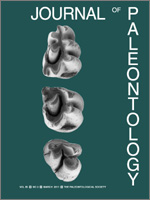The Walcott-Rust Quarry echinoderm fauna lived at the base of a carbonate ramp in moderately deep water (Benthic Assemblage 5 of Boucot and others) below wave base for all or most storms but within the photic zone. The inhabitants of the soft substrate were buried rapidly by distal carbonate turbidity currents or mudflows. Because of the episodic sedimentation, the organisms were opportunistic. The suspension-feeding echinoderms include nine crinoids, a rhombiferan, and a paracrinoid. They occur with a variety of filter-feeding bryozoan colonies, a few brachiopods, and numerous trilobites. Most suspension-feeding echinoderms were attached by small holdfasts to hard shelly substrates. Some of these substrates lay on the seafloor, whereas others may have been elevated when the larvae settled. Other types of holdfasts are distal stems that are tightly and permanently coiled around crinoid stems, open distal stem coils that lay on the substrate or were wrapped around soft objects, and recumbent stems running along the seafloor. The echinoderms occupied levels from the seafloor to almost a meter above it, whereas the bryozoans and brachiopods ranged from the seabed to a maximum height of about 10 cm. The sizes of the echinoderm food grooves and comparisons with their modern analogues along with filtration theory indicate that they ate food particles that were mostly larger than those taken by bryozoans. In general, the different taxa of suspension-feeding echinoderms living at the same elevation above the seafloor collected food particles of different maximum sizes and different mean sizes; however, they overlapped greatly with respect to smaller food items. The various crinoid species were able to feed at different ranges of ambient current velocities, which also tended to separate them ecologically. Crinoids having narrow food grooves were restricted to feeding on small food particles but they caught food items over a wide range of current velocities; the converse is also true, which suggests an evolutionary or behavioral tradeoff. As in most Ordovician crinoid communities, predation was comparatively low. Regenerated arms in crinoids reflect predation on about 1.8% of the individuals in the fauna and the most likely fossilized culprits are trilobites and straight nautiloids. Competition for space and attachment sites within and between species of the Walcott-Rust Quarry crinoid and rhombiferan assemblages does not seem to have been significant in regulating their ecological structure. Comparison with shallow-water crinoid assemblages of roughly the same age demonstrates that the Walcott-Rust Quarry faunas were less diverse and less complex. This could be caused by one or more of the following conditions that affected the Walcott-Rust fauna: lower average current velocities, the episodic sedimentological disturbances, higher suspended sediment content in the water, and softer substrates.
How to translate text using browser tools
1 March 2011
Paleoecology of Suspension-Feeding Echinoderm Assemblages from the Upper Ordovician (Katian, Shermanian) Walcott-Rust Quarry of New York
James C. Brower
ACCESS THE FULL ARTICLE

Journal of Paleontology
Vol. 85 • No. 2
March 2011
Vol. 85 • No. 2
March 2011
Echinodermata
Paleoecology
Rust Formation
Shermanian
Trenton Group
Upper Ordovician
Walcott-Rust Quarry




